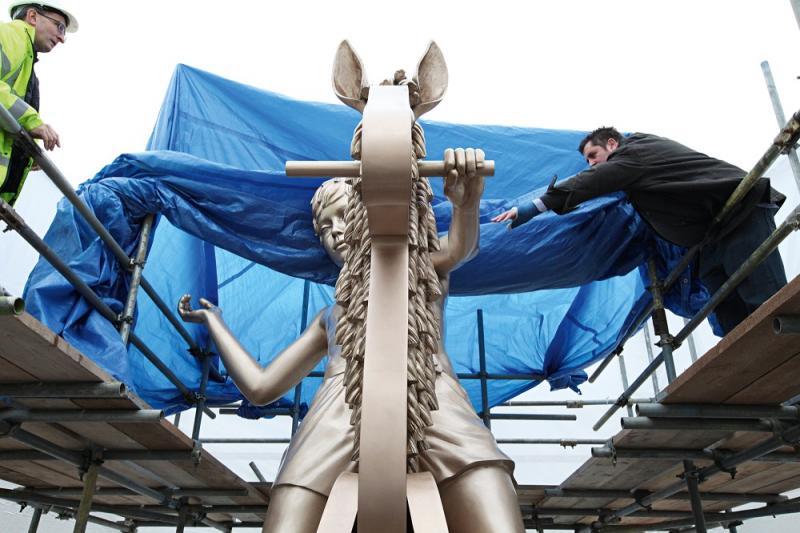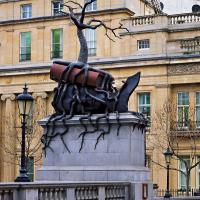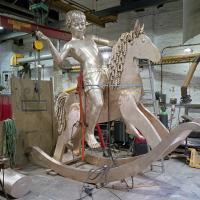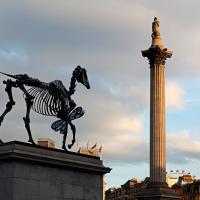Fourth Plinth: How London Created the Smallest Sculpture Park in the World | reviews, news & interviews
Fourth Plinth: How London Created the Smallest Sculpture Park in the World
Fourth Plinth: How London Created the Smallest Sculpture Park in the World
Celebrating Trafalgar Square's infamous empty plinth, and its role in changing attitudes to contemporary art

I have always felt very lucky to have been working as an artist in London during the period when it transformed into the capital of the art world. It has been a beautiful, fascinating and profitable ride.
For me, the watershed moment came in 2009. The experience that finally convinced me that art was no longer an obscure cult was listening to a storyline in Radio 4’s middle-England soap opera The Archers. The programme has been running for more than 60 years and is no hotbed of the avant-garde. So when Lynda Snell, the self- appointed cultural ambassador for Ambridge, campaigned to get someone from the fictional village onto the Fourth Plinth during Antony Gormley’s One and Other project, I sensed the game was won… or lost. I thought that if Lynda was a fan of a piece of participatory performance art, then no corner of the national psyche had been left untouched by the legacy of Marcel Duchamp.
It is fitting that my moment of realisation was triggered by the Fourth Plinth, for it has acted as the pivot for many debates about contemporary life and art since its inception in 1999. The art works serve as a provocation to the grand establishment figures arrayed around our most public of squares. The works have stood above the roar of the traffic, sometimes asking difficult questions, sometimes raising a smile, often doing both. Trafalgar Square is no neutral white cube; and all of the artists have taken up the challenge of intervening in this most political of spaces. But today are the works standing there as hecklers to the powers-that-be or are they yet more officials speaking to the crowd? The Fourth Plinth is a reminder to the art world that it has been allowed in. Contemporary art is no longer a little-understood craze in Britain. It is now one of the "creative industries", a gaudy feather in the cap of UK plc, a huge tourist draw and regenerator of run-down provincial towns. It has come of age. Maybe it feels it deserves the Fourth Plinth now. Maybe it is comfortable up there. Good. Long may art reign over us!
- Ths is an extract from Fourth Plinth: How London Created the Smallest Sculpture Park in the World, with texts by Isabel de Vasconcellos, published by Art / Books, £22.50 hardback
- www.artbookspublishing.co.uk
Share this article
The future of Arts Journalism
You can stop theartsdesk.com closing!
We urgently need financing to survive. Our fundraising drive has thus far raised £49,000 but we need to reach £100,000 or we will be forced to close. Please contribute here: https://gofund.me/c3f6033d
And if you can forward this information to anyone who might assist, we’d be grateful.

Subscribe to theartsdesk.com
Thank you for continuing to read our work on theartsdesk.com. For unlimited access to every article in its entirety, including our archive of more than 15,000 pieces, we're asking for £5 per month or £40 per year. We feel it's a very good deal, and hope you do too.
To take a subscription now simply click here.
And if you're looking for that extra gift for a friend or family member, why not treat them to a theartsdesk.com gift subscription?
more Visual arts
 'We are bowled over!' Thank you for your messages of love and support
Much-appreciated words of commendation from readers and the cultural community
'We are bowled over!' Thank you for your messages of love and support
Much-appreciated words of commendation from readers and the cultural community
![SEX MONEY RACE RELIGION [2016] by Gilbert and George. Installation shot of Gilbert & George 21ST CENTURY PICTURES Hayward Gallery](https://theartsdesk.com/sites/default/files/styles/thumbnail/public/mastimages/Gilbert%20%26%20George_%2021ST%20CENTURY%20PICTURES.%20SEX%20MONEY%20RACE%20RELIGION%20%5B2016%5D.%20Photo_%20Mark%20Blower.%20Courtesy%20of%20the%20Gilbert%20%26%20George%20and%20the%20Hayward%20Gallery._0.jpg?itok=7tVsLyR-) Gilbert & George, 21st Century Pictures, Hayward Gallery review - brash, bright and not so beautiful
The couple's coloured photomontages shout louder than ever, causing sensory overload
Gilbert & George, 21st Century Pictures, Hayward Gallery review - brash, bright and not so beautiful
The couple's coloured photomontages shout louder than ever, causing sensory overload
 Lee Miller, Tate Britain review - an extraordinary career that remains an enigma
Fashion photographer, artist or war reporter; will the real Lee Miller please step forward?
Lee Miller, Tate Britain review - an extraordinary career that remains an enigma
Fashion photographer, artist or war reporter; will the real Lee Miller please step forward?
 Kerry James Marshall: The Histories, Royal Academy review - a triumphant celebration of blackness
Room after room of glorious paintings
Kerry James Marshall: The Histories, Royal Academy review - a triumphant celebration of blackness
Room after room of glorious paintings
 Folkestone Triennial 2025 - landscape, seascape, art lovers' escape
Locally rooted festival brings home many but not all global concerns
Folkestone Triennial 2025 - landscape, seascape, art lovers' escape
Locally rooted festival brings home many but not all global concerns
 Sir Brian Clarke (1953-2025) - a personal tribute
Remembering an artist with a gift for the transcendent
Sir Brian Clarke (1953-2025) - a personal tribute
Remembering an artist with a gift for the transcendent
 Emily Kam Kngwarray, Tate Modern review - glimpses of another world
Pictures that are an affirmation of belonging
Emily Kam Kngwarray, Tate Modern review - glimpses of another world
Pictures that are an affirmation of belonging
 Kiefer / Van Gogh, Royal Academy review - a pairing of opposites
Small scale intensity meets large scale melodrama
Kiefer / Van Gogh, Royal Academy review - a pairing of opposites
Small scale intensity meets large scale melodrama
 Jenny Saville: The Anatomy of Painting, National Portrait Gallery review - a protégé losing her way
A brilliant painter in search of a worthwhile subject
Jenny Saville: The Anatomy of Painting, National Portrait Gallery review - a protégé losing her way
A brilliant painter in search of a worthwhile subject
 Abstract Erotic, Courtauld Gallery review - sculpture that is sensuous, funny and subversive
Testing the boundaries of good taste, and winning
Abstract Erotic, Courtauld Gallery review - sculpture that is sensuous, funny and subversive
Testing the boundaries of good taste, and winning
 Edward Burra, Tate Britain review - watercolour made mainstream
Social satire with a nasty bite
Edward Burra, Tate Britain review - watercolour made mainstream
Social satire with a nasty bite
 Ithell Colquhoun, Tate Britain review - revelations of a weird and wonderful world
Emanations from the unconscious
Ithell Colquhoun, Tate Britain review - revelations of a weird and wonderful world
Emanations from the unconscious















Add comment